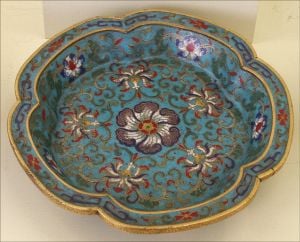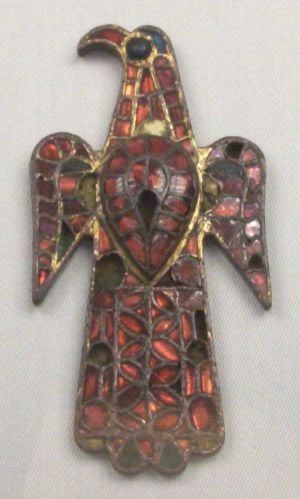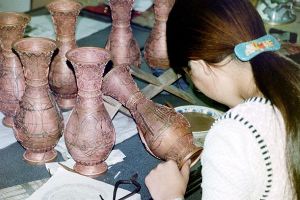Cloisonné
Cloisonné, an ancient metalworking technique, is a multi-step enamel process used to produce jewelry, vases, and other decorative items. Objects produced by this process are also called cloisonné.

History
Cloisonné first developed in the Near East. It spread to the Byzantine Empire and from there along the Silk Road to China. Chinese cloisonné is probably the most well known and ubiquitous. Russian cloisonné from the Tsarist era is highly prized by collectors. Chinese cloisonné is sometimes confused with Canton enamel, a similar type of enamel work that is painted on freehand and does not utilize partitions to hold the colors separate.
Cloisonné process

- A paper pattern and a pencil are used to transfer a design to the metal object.
- Partitions (French: cloisons) that act as color-separators are applied according to the transferred pattern and are held in place by a soldering paste (this is finely divided metal of low melting temperature in a flux paste). The partitions are bent and cut to length from flat wire stock (usually by hand using simple pliers) while the paste is applied with a small brush.
- Heating the piece in an oven permanently affixes the partitions to the base metal by melting the solder. The piece is then allowed to cool.
- Frit (glass crushed to a powder) in a water-based paste is painted into the partitions using an annotated pattern similar to the "paint by numbers" craft technique. After the frit has dried, firing in an oven melts it onto the metal. Several repetitions of the process may ensue to build up the coatings to the height of the partitions. Various colors and transparencies may be used in combination within a single partition to obtain the desired artistic effect.
- The glass and a portion of the cloisons are ground and polished to form an even and smooth surface.
- The exposed metal is electroplated with a thin film of gold to prevent corrosion and to give a pleasing appearance.
Beads
Cloisonné beads also occur commonly; and one use of Chinese cloisonné beads involves making jewelry.
Other examples
- The Pala d'Oro, Saint Mark's Cathedral, Venice
- The Alfred Jewel, a 9th-century Anglo-Saxon ornament
See also
- Vitreous enamel
- Champlevé enamel
External links
- An Interview with Contemporary Enamel Artist Laura Zell Demonstrating Basic Cloisonné Techniques
- Japanese Cloisonné: the Seven Treasures. Asia. Victoria and Albert Museum. Retrieved 2007-10-20.
Gallery
Chinese Imperial Queen's headdress of the Ming Dynasty, leaf patterns are made in a single light blue color with each element bounded by a rim, making this a work with cloisonné rather than simply enameled copper.
A Chinese cloisonne stupa dated to the reign of the Qianlong Emperor (1735-1796)
{{
fy:Selemalje
Credits
New World Encyclopedia writers and editors rewrote and completed the Wikipedia article in accordance with New World Encyclopedia standards. This article abides by terms of the Creative Commons CC-by-sa 3.0 License (CC-by-sa), which may be used and disseminated with proper attribution. Credit is due under the terms of this license that can reference both the New World Encyclopedia contributors and the selfless volunteer contributors of the Wikimedia Foundation. To cite this article click here for a list of acceptable citing formats.The history of earlier contributions by wikipedians is accessible to researchers here:
The history of this article since it was imported to New World Encyclopedia:
Note: Some restrictions may apply to use of individual images which are separately licensed.





